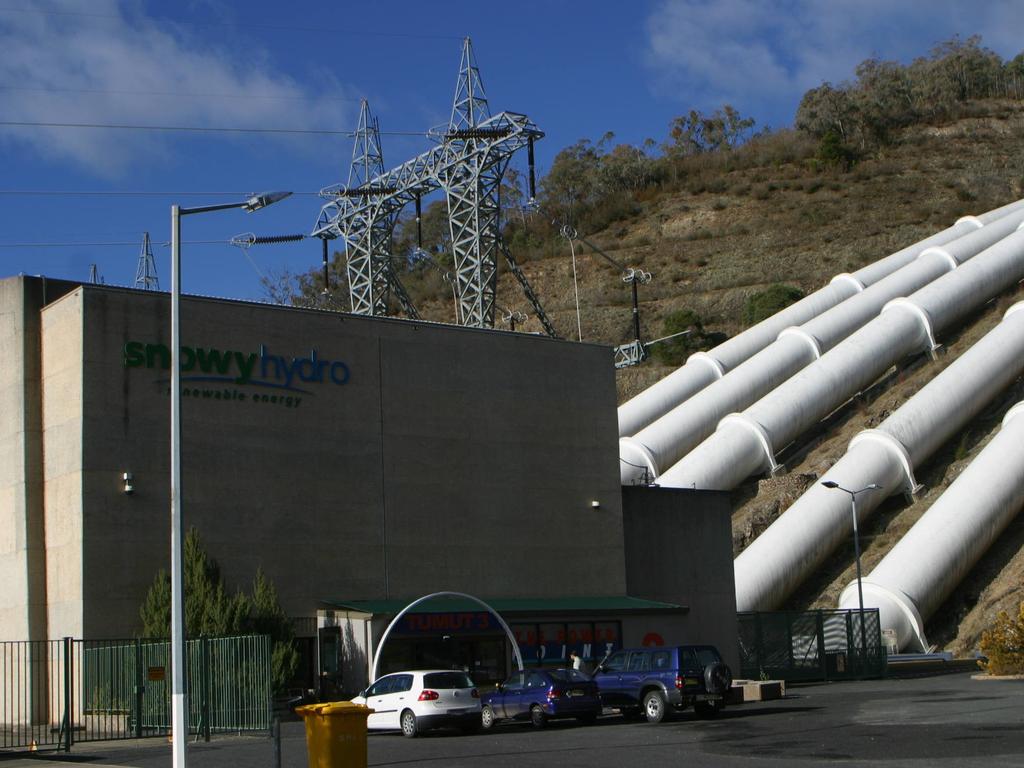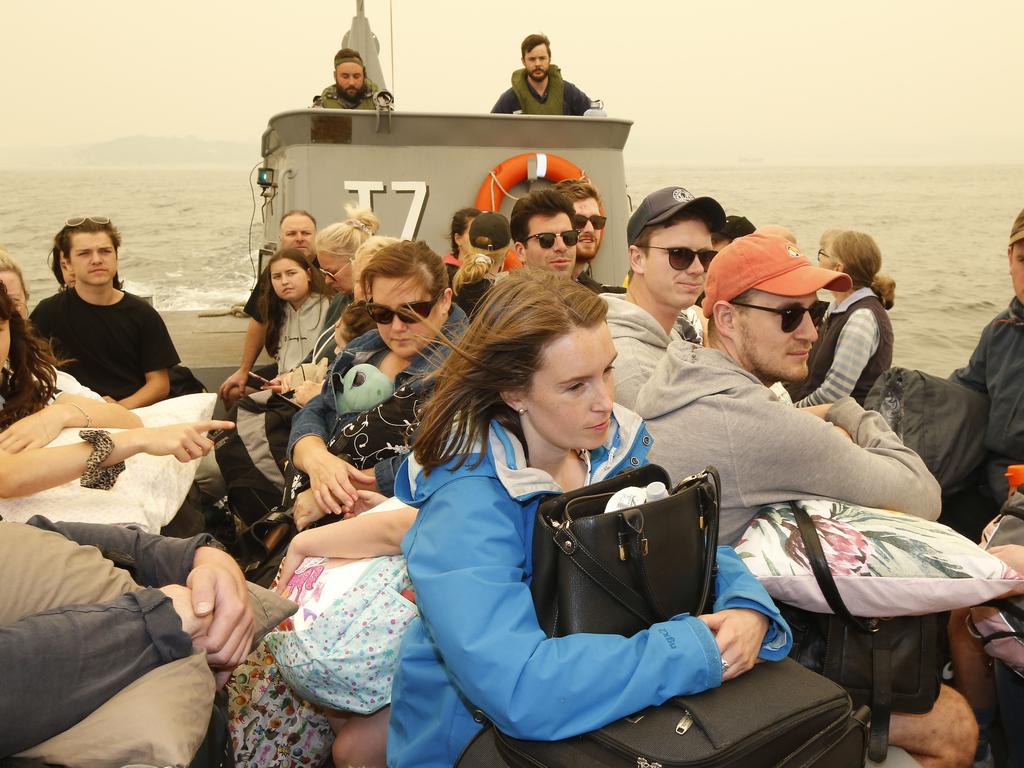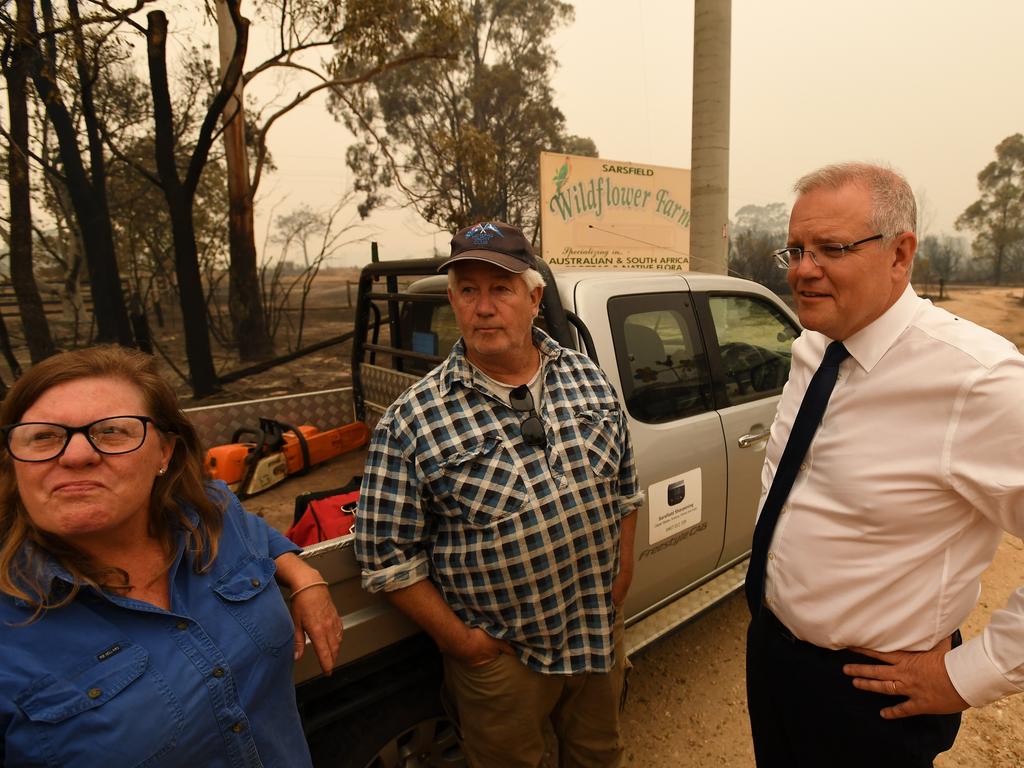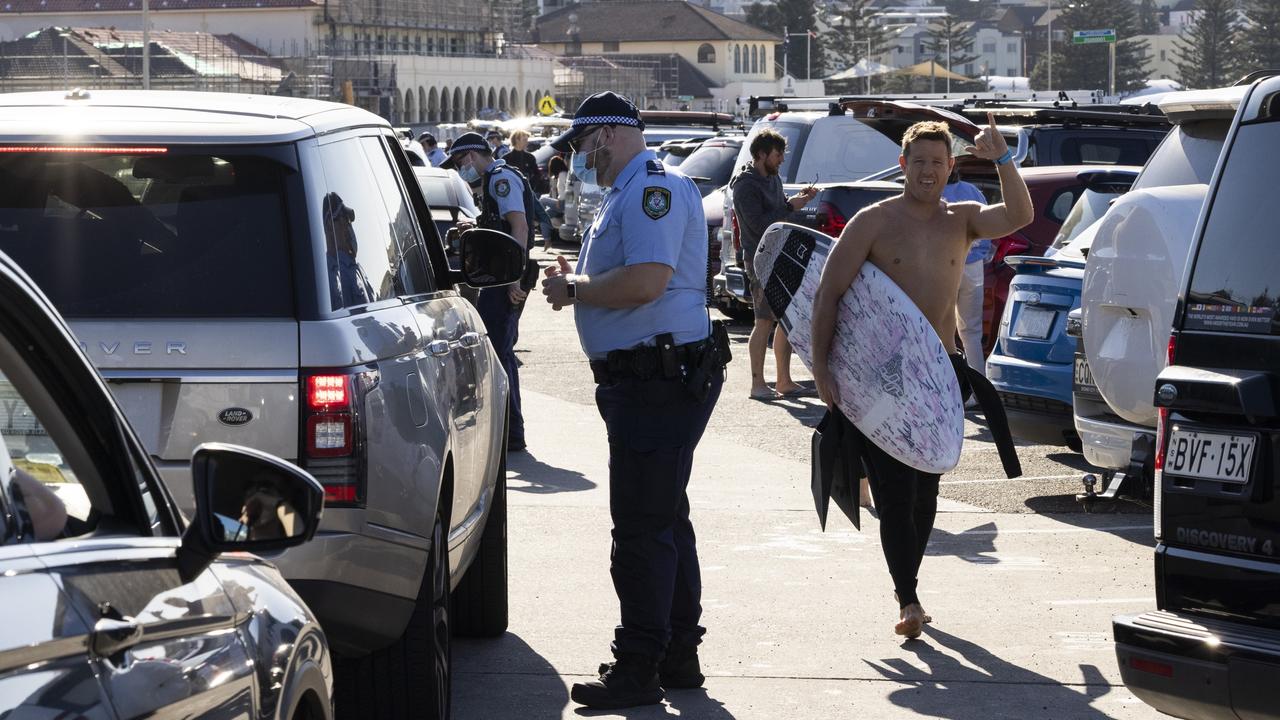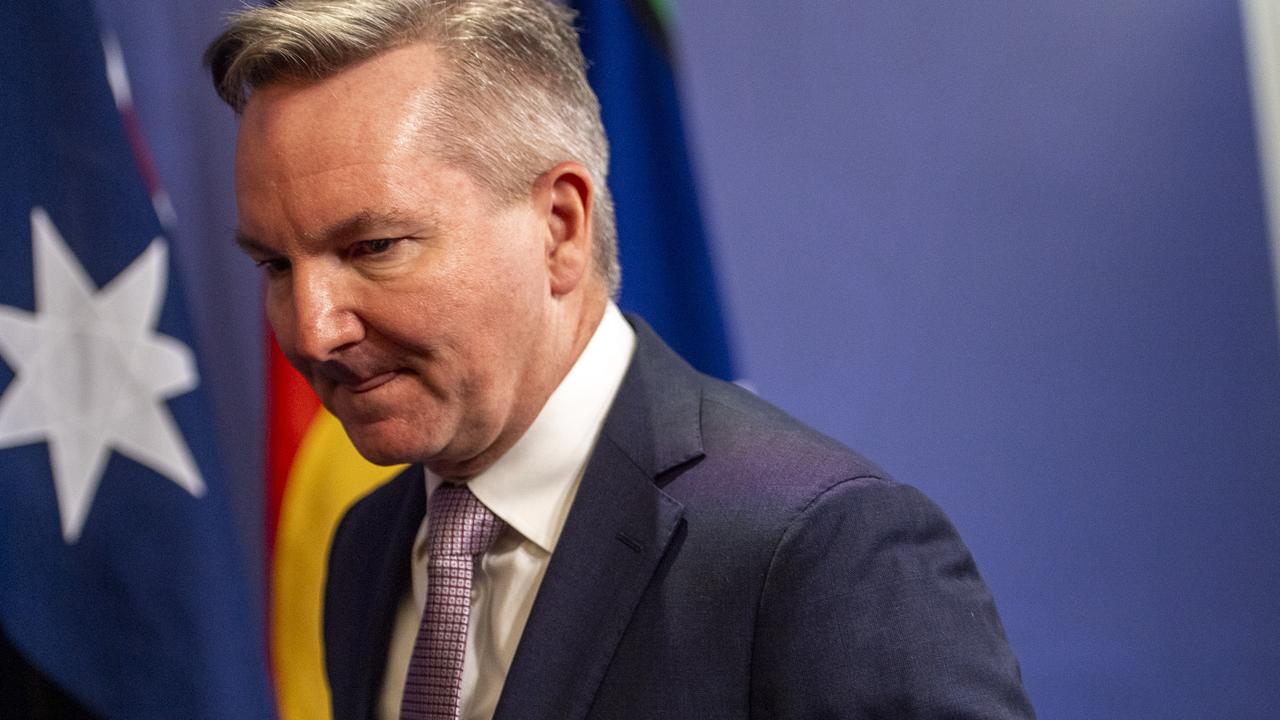Bushfire forces braced for battle as extreme conditions awaited
Tens of thousands of people remain in the fire danger zone this weekend despite a mass evacuation ahead of extreme conditions.
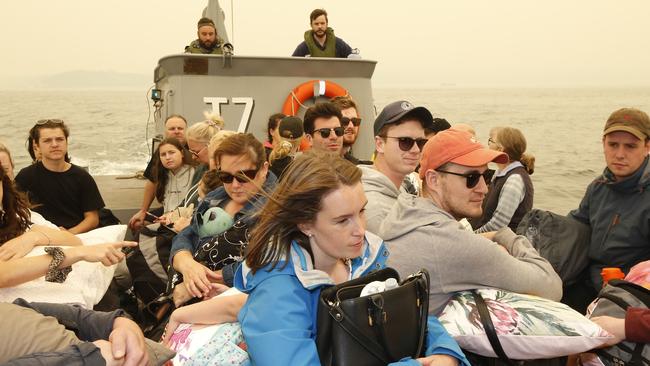
Tens of thousands of people, including those trapped in up to 30 isolated communities, remain in the fire danger zone this weekend despite a mass evacuation ahead of extreme conditions posing an “unprecedented risk to life and property”.
About 1000 people who had been stranded at Mallacoota in East Gippsland since New Year’s Eve were expected to dock at Hastings, south of Melbourne, on Saturday, having travelled up to 20 hours by sea aboard HMAS Choules and its support vessel, MV Sycamore.
They were the first of multiple missions, including evacuations by helicopter, planned over coming days to extract up to 4000 people from the far-east township.
NSW and Victoria have declared a state of emergency — referred to as a “state of disaster” in the southern state — giving the governments overriding authority to remove people from at-risk areas as temperatures are set to soar above 40C in Victoria and NSW.
Visiting Gippsland on Friday, Scott Morrison described the conditions as “unprecedented”, noting they had come off the back of years of drought. He warned of a “gruelling’’ 24 hours ahead.
Victorian Premier Dan Andrews described the predicament as an “unprecedented risk to life and property”.
“If you can leave, you must leave. We cannot guarantee your safety,” Mr Andrews said.
Victorian fire authorities estimated there were up to 100,000 people in the potential fire impact area, which covers 35,000sq km and spans six municipalities across the north and east of the state, and urged them to get out immediately. In NSW there were fears that up to 120,000 people could be trapped over the weekend as looming firestorms threaten to engulf communities from Nowra to the Victorian border, and west to Kosciuszko.
Residents and tourists in Batlow, the Shoalhaven, Batemans Bay, the Snowy and Monaro regions and Khancoban may be cut off from escape routes after a “brief window” to get out of the 250km-long disaster zone closed on Friday night. Victorian authorities have been unable to quantify the number of people who are trapped.
They have warned that Saturday’s conditions would be worse than on Monday, when fires increased by about 500,000ha as separate fires merged. About 50 fires are burning across the state, covering about 800,000ha, and in NSW there are 138 fires, including 74 uncontained. A new emergency warning was issued for a bushfire burning near Batlow, in southern NSW, just after 5.30pm on Friday.
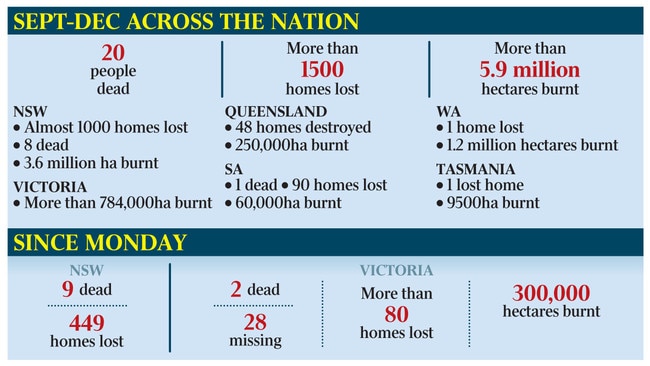
In Victoria there are grave fears for 28 people unaccounted for almost a week after Monday’s fires. The horror fire season has so far claimed 20 lives — 17 in NSW, two in Victoria and one in South Australia — after NSW police confirmed on Friday that they had found the body of Colin Burns, 72, inside a burnt-out vehicle 50km northwest of Cobargo.
Mr Burns, a former volunteer firefighter, was killed when the Badja fire ripped through the state’s south coast.
The Prime Minister, who received a less hostile reception from locals than he did a day earlier when he travelled to Cobargo, warned the crisis would continue.
“The fire risk is still there in the months, not the weeks ahead,” he said. Unlike a week ago, when holidaymakers along the East Gippsland coastline defied warnings to leave, choosing instead to stay put to ring in the New Year, tourists appear to have heeded the warnings.
An exodus was under way on Friday as thousands of tourists abandoned their holiday rentals. In NSW, thousands of displaced people flooded the Princes Highway, crowding the roads from Milton to Nowra, while police escorts were needed to get fuel to petrol stations in Moruya.
Residents in the town of Batlow — known as Australia’s apple capital — were ordered to “get out” on Friday, because the “township will not be defendable”.
Bright, a mecca for outdoor sports that attracts 15,000 people at this time of year, is now a ghost town, while Lakes Entrance, which had up to 30,000 tourists a week ago, was in lockdown.
Victorian Emergency Services Minister Lisa Neville, who made the recommendation that a “state of disaster” be declared, the first time since the law came into effect after the Black Saturday fires 11 years ago, urged those in fire zones to take evacuation orders seriously.
“I’ve spent the last couple of days down in East Gippsland talking to people … (and) I think the strong message from those who didn’t leave is that they wished they had left, that the fires were of such ferocity and intensity that it was very traumatic and people felt that their lives were absolutely at risk,” she said. “We can rebuild properties. We can’t rebuild lives.”
While there are significant concerns about new fires across the Alpine region, and for the area around Corryong in the north, fire chiefs warned that communities across East Gippsland, which copped the brunt of Monday’s blast, were still in danger. About 3000 people remain at Mallacoota and they are bracing for another potential onslaught.
Bruthen and Buchan, where homes have been lost, were both subject of fresh evacuation orders late on Friday. Gippsland’s deputy chief fire officer, Beth Roberts, warned: “Not all the fuels have been burnt.”
CFA chief officer Steve Warrington expressed concerns for 20 to 30 communities in the region that remained isolated, including Genoa, where up to 30 people are trapped. “We’ve tried to get trucks in from NSW and the RFS, we’ve tried a few times to get them in from the CFA … and we’ve been unable to get trucks into Genoa,” he said. “That community is bunkered down on its own without any fire trucks. There are communities that cannot remove (themselves) and we’re trying to support them as best we can.”
Genoa resident Leanna Servers said homes had been lost and those who remained had been trying to stop spot fires. There is no electricity, little food and people have been running low on fuel, she said. “We are cut off,” Ms Severs said. “We are all alone here.”
Despite the risks, there are people who are committed to remaining to fight fire outbreaks. While authorities have the power to compel people to leave, those with a “pecuniary interest” in a property are exempt. Ms Neville said there were no plans to arrest people who declined to evacuate.
In the King Valley, where there are several nearby fires, evacuation warnings have been issued for Abbeyard, Bennies, Cheshunt, Cheshunt South, Dandongadale, Edi, Edi Upper, King Valley, Rose River, Whitfield and Whitlands.
About 250 people attended a meeting at the Whitfield recreation reserve on Friday, where the message from the CFA was to enact fire plans or leave now.
Additional reporting: Mark Schliebs, Stephen Lunn, Kieran Gair

